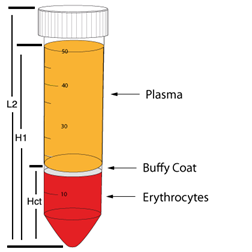
Angle = the angle of the centrifuge tube. For swing-bucket centrifuges this will be ‘horizontal”. For most smaller fixed angle centrifuges it will be 45 degrees.
L1 = the distance in centimeters from the center of the rotor hub to the center of the top of the centrifuge tube.
L2 = the length in centimeters of the centrifuge tube.
H1 = the height in centimeters of the column of fluid (blood) in the centrifuge tube.
Hematocrit = the hematocrit (packed cell volume in %) of the blood sample
Rmin = the radius (in cm) to the top of the fluid column.
Rmid = the radius (in cm) to the midpoint of the fluid column.
Rhct = the radius (in cm) to the platelet layer (buffy coat) of the centrifuged blood.
Rmax = the radius (in cm) to the bottom of the fluid column.
Most PRP preparation methods prescribe centrifugation at a certain G-force for a specified time. However, most centrifuges are not calibrated in G-force, but in RPM, and those that are calibrated in g use Rmax as the default target level.
Since platelets are of intermediate density among blood components they will concentrate somewhere in the middle of the column of fluid. In some preparations you can see this as the buffy coat. In making PRP the platelets are the target cell population and thus the radius used in the computation of RPM should, for the highest accuracy, be the distance from the rotor hub to the buffy coat. If you use some other radius then the calculation will be applicable only to the specific model of centrifuge that you are using. If you (or someone else) use a different centrifuge it will likely have a different radius and therefore a different G-force at the same RPM.
To eliminate this problem you should use either Rmid as an estimate of the radius to the buffy coat, or calculate it exactly by using the hematocrit. A G-force calculated in this way will translate accurately to any other centrifuge.